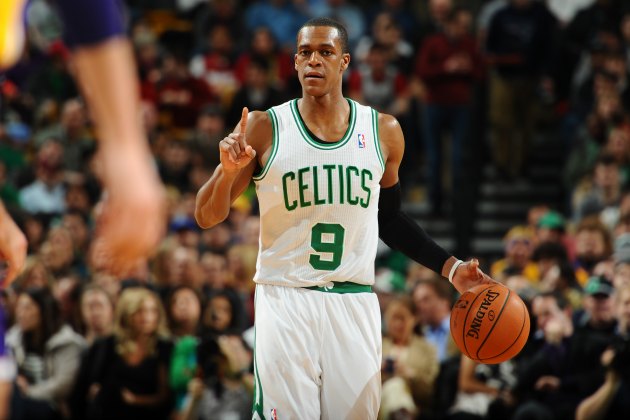This NBA season has been marred by many high-profile injuries, including the continued poor health and extended stays on the sidelines from Derrick Rose, Russell Westbrook, and Kobe Bryant. While the league still has much to recommend, the absence of so many big-name players has certainly affected the tenor of the season.
On Friday night, though, one big name returned to action after a lengthy stretch away from the court. Boston Celtics point guard Rajon Rondo, who tore the ACL in his right knee nearly a year ago, returned to action against the visiting Los Angeles Lakers. Although the rebuilding Celtics look very different from the team Rondo last played with in January 2013, it was a major moment for the franchise and their returning star.
It was a night of ups and downs for the famously unorthodox Rondo. Starting the game, he was fairly uninspiring in his first five minutes. But things picked up when he re-entered the game in the second quarter. In a flurry of offensive activity, Rondo scored his first two baskets of the season on consecutive possessions. The first came on his signature move — the fake behind-the-back pass that creates space for a lay-up — and the next involved Rondo pushing the ball himself in transition.
This clip gives a sense of what Rondo looked like at his best on Friday night. The moves and talent are there, but he's also clearly not moving at what's typically been his top speed. It was obvious enough, in fact, that notoriously homer-ish Celtics announcer Tommy Heinsohn admitted that he wasn't dribbling up court with quite the intensity of old.
Nevertheless, this second-quarter stretch provided hope that Rondo can make it all the way back. While the Lakers defense barely resembles an NBA-level unit right now, Rondo's 4-of-5 shooting over this period indicates that he's capable of finding his old form.
Unfortunately, his night had its share of problematic moments. Rondo didn't create with quite the same verve and ingenuity that's made him one of the most consistently fascinating players in the NBA, although he did have a nice pass to find Avery Bradley for a three-pointer in transition. Plus, while he's never been a particularly great shooter (despite meaningful improvement), Rondo didn't look comfortable on the perimeter.
The worst stretch, by far, came in crunch time. Holding a 97-94 lead with 4:52 remaining in the fourth quarter, Rondo entered the game for sparkplug backup Phil Pressey. The Celtics scored seven points in the next 100 seconds (with one field goal coming off a Rondo assist), but they failed to score over the final 3:12 and ended up with a disappointing 107-104 loss. With Rondo running the offense, Boston executed very poorly and failed to generate threats. Some of that poor performance can be chalked up to bad shooting luck, but Rondo did little to impress.
His stat line sums up the good and bad: eight points (4-of-9 FG), four assists, two steals, and a -8 plus-minus in 19 minutes of action.
Yet, in a broad sense, it was exciting just to see him back on the court. The positive moments were there, if mostly limited to one stretch, but the joy of watching Rondo extends to nearly every part of his game. Even when struggling, he's liable to pull out a series of plays other point guards just can't match. Take, for instance, a sequence in the last few minutes that included an airballed runner (called a pass in the official play-by-play), an offensive rebound along the baseline on Gerald Wallace's subsequent miss, and a box-out on that miss that led to another (missed) opportunity for Kelly Olynyk.
Rondo remains startlingly unique, through a mixed bag of a performance or not. The NBA is better off with him on the court, no matter if he's found his form just yet.
- - - - - - -Eric Freeman is a writer for Ball Don't Lie on Yahoo Sports. Have a tip? Email him at [email protected] or follow him on Twitter! Follow @FreemanEric Stay connected with Ball Don't Lie on Twitter @YahooBDL and "Like" BDL on Facebook for year-round NBA talk, jokes and more.
|
|
|
Results 1 to 1 of 1
-
01-18-2014, 08:00 AM #1Administrator



- Join Date
- Jun 2007
- Location
- Canada
- Age
- 49
- Posts
- 60,916
- Blog Entries
- 3
- Downloads
- 9
- Uploads
- 12429
 Rajon Rondo returns to the Celtics, scores first points with signature move (Video)
Rajon Rondo returns to the Celtics, scores first points with signature move (Video)
Similar Threads
-
The Celtics’ locker room votes to pick the winner of a hypothetical Rajon Rondo vs. K
By admin in forum Sports NewsReplies: 0Last Post: 10-07-2013, 01:31 PM -
Celtics Beat Heat without Rajon Rondo
By vlad411 in forum TechnoZoneReplies: 0Last Post: 01-29-2013, 12:00 AM -
LeBron James snuffs out Rajon Rondo?s signature ball fake with a big block (VIDEO)
By admin in forum Sports NewsReplies: 0Last Post: 05-29-2012, 10:54 AM -
Video: Rajon Rondo Cameraman Fight
By vlad411 in forum TechnoZoneReplies: 0Last Post: 05-10-2012, 08:23 AM -
Video: Rajon Rondo Dislocated Elbow
By vlad411 in forum TechnoZoneReplies: 0Last Post: 05-11-2011, 09:08 PM






 Reply With Quote
Reply With Quote
Bookmarks